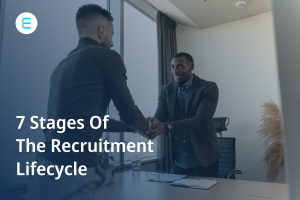Talent acquisition is undeniably one of the most important drivers of an organization’s success. The focus is on finding the talent that are best aligned to the company’s business goals and vision, while optimizing hiring cost and effort. With finding top talent for the open positions being a difficult endeavour, it becomes necessary to strategize to hire the best talent.
The Recruitment Life Cycle comprises key staffing stages, right from the scoping of the talent needs, to an engaging interview process to a wow final onboarding. Every aspect of the recruitment process must be carefully planned and orchestrated to attract and retain high quality talent; hence the need for a coherent and dynamic hiring strategy.
Let’s take a look at the different elements at play when it comes to curating a comprehensive and efficient recruitment process to build a strong market brand and have higher business outcomes.
What is the Recruitment Life Cycle?
The recruitment life cycle starts with a business need and is considered closed upon onboarding of the right person for the role. It consists of all the different stages in hiring, from sourcing, screening, selecting to retaining highly skilled individuals.
With the war on for skilled Talent, per the National Federation of Independent Business, 26% of small businesses quote their number one challenge being the inability to attract qualified workers.. Regardless of the size of the organizations, the mode of hiring, or the kind of workers being sought, it is important to attract top talent through a highly efficient hiring process.
In this backdrop, a supreme candidate experience becomes vital to connecting, engaging with and finally hiring top talent. With the candidate journey taking center-stage, many companies are now turning to AI based recruitment software to optimize recruitment effort and enhance brand perception.

Recruitment Life Cycle’s 7 Critical Stages
The recruitment life cycle consists of all the different stages from preparing clear JDs, sourcing, screening, interviewing to hiring top notch employees for the organization to have a market edge.
With every phase of the recruitment life cycle deserving the same attention and diligence, it is important to critically review and lay out the expectations and outcomes of each phase clearly.
In order to hire top talent, it becomes imperative to plan and execute the 7 stages in the most efficient manner.
Stage 1 – Preparing the Job Description

After identifying the hiring needs, a candidate persona must be defined with the qualities and expectations of an ideal candidate. The aptitude and cultural fitment must be treated at par with the academic and professional qualifications. So, the personal qualities such as communication, learnability and cultural alignment must be considered along with the skills, education and experience.
The detailed JD must then be created with a clear articulation of the roles and responsibilities. The JD must be comprehensive with extensive details around the company, values, title, duties, qualification & skills, location and the total benefits (compensation, perks & other benefits).
JD being the first opportunity to create a positive brand image, it must be phrased appropriately. The JD wording should be unbiased, gender agnostic and cater to all aspects of diversity.
Stage 2 – Sourcing Candidates
In order to tap into a rich, vast pool of diverse talent, adequate effort must be taken to widen the outreach. Leverage employee referrals, job/career portals, job fairs, social media, placement agencies and the company website to engage with a big pool of highly skilled people and motivate them to apply for the open positions.
Based on company policies, internal hiring can be a source of good talent too, one that ensures retention with wider cost benefits. Previous applicants and retired employees can also be a part of the candidate pool.
Stage 3 – Screening Candidates
Once an acceptable number of profiles have been sourced, the next step is to perform a screening based on the degree of fitment against the candidate persona. Then, further sorting can be on the basis of specific skills, domain knowledge and certifications.
Once the resumes have been shortlisted, a casual telephonic conversation can help the recruiter get a better picture of their communication skills and relevant experience.
Stage 4 – Selecting & Interviewing Candidates
The shortlisted candidates can then be scheduled for in-person or virtual interviews based on the availability and convenience of the candidates and hiring managers.
An objective evaluation of the candidate on the basis of their professional and personal credentials with an emphasis on the behavioural aspects help find a good fit for the role. The rounds of evaluation depend on the unique needs and criticality of the role. Prior to the interviews, online evaluation tools can also be utilized to improve the efficacy of the hiring process.
Step 1: Psychometric Test
As a first step, Psychometric tests help measure the fitment of a candidate’s personality, aptitude and ability to those essential for the open staffing positions. These enable the hiring of talent that are the right cultural fit for the company, closely aligned to their values and vision.
Step 2: Technical Assessment
Coding assessments help evaluate a candidate’s technical proficiency, a combination of their technical knowledge and job relevant skills. So, prior to the technical interview, a comprehensive programming test helps identify the technical talent that are best suited for the company’s open positions.
The selection & interview stage is a labour intensive one with a higher risk of adversely impacting the candidate experience and thereby the brand image. Towards this, a clear strategy on the below enables higher candidate conversions.
- Recruitment CRM
- Post Offer Candidate Engagement
A feature-rich Recruitment CRM helps optimize recruitment effort and provides a clear and comprehensive view of the candidate journey. During the Selection, Hiring and Post Offer stages, real-time stats, reports and insights, enable the hiring team to intervene appropriately and promote a strong brand image.
Stage 5 – Hiring a Candidate
Once a decision has been made on hiring a candidate, a formal offer letter with details of employment is sent to the candidate. It states in clear and unambiguous terms the start date, conditions of employment, title, location, compensation & other benefits the candidate is eligible for, should they join the company.
Post offer acceptance, reference and background verification checks can be conducted to finalize their employment.
Stage 6 – Post Offer Candidate Engagement
Post-offer dropouts being a prominent concern in hiring of late, active engagement with prospective candidates during this phase becomes crucial. The below practices contribute towards a better candidate engagement and experience:
- Commence a cultural immersion early by facilitating interaction with leaders, introduction to team members and invitation to company events
- Encourage them to update their social media as it reduces the chances of them declining the offer later on
- Hiring managers should connect and forge a relationship with the prospective associates, exciting them with a view of the project and work planned ahead
- Arrangements must be made to ensure all the queries of the candidate are answered promptly and appropriately, both by recruiters and hiring managers
Recruitment CRMs are of immense help in this stage, reducing recruiter effort by automating transactional interactions (chatbots) while enabling more engaging and meaningful conversations with the recruiters and company leaders. This helps build a strong brand image and helps a closer integration of the candidate to the company.
Stage 7 – Onboarding Employee
While onboarding a candidate is the final stage of the recruitment life cycle, it can be commenced ahead of the actual start date through informal conversations and meet ups with the hiring manager, team and other leaders in the company.
Comfort and convenience of the candidates should be of utmost priority when bringing them into the company with buddies helping them settle in with relative ease. During the induction, the employment contract is signed and the formal orientation and mandatory training programs are kicked off.
The outcome of a successful recruitment lifecycle is a delighted and engaged employee who has all the required company information and a clear view of their role and work.
Wrapping Up
Talent acquisition being critical to a company’s growth and profitability, it has achieved prominence in the company’s business strategy. Ever-growing competition and a dearth of talented workers are making it imperative to review all the above-mentioned stages of Recruitment life cycle critically for gaps and optimize the overall hiring process.
With the increasing demand for optimization and cost-efficiency, integration of AI based Recruitment CRM and other hiring tools into the Recruitment life cycle helps streamline the company’s talent acquisition process, enabling them to stay competitive in their space and progress strongly on their business goals.
FAQs related to Recruitment Lifecycle
What is the lifecycle of recruiting?
The complete lifecycle of recruiting is the end to end process of onboarding a new employee from sourcing to hiring. The various stages of the recruitment life cycle are preparation, sourcing, screening, selecting, hiring and onboarding. In order to hire top talent, it becomes extremely important to optimize the recruitment process and enhance candidate experience through the use of a recruitment CRM.
How long is a recruiting cycle?
The average hiring process is 42 days long, according to the Society of Human Resource Management (SHRM). Other studies report an average of 27 working days.
What is candidate outreach?
Candidate outreach is reaching out to potential or prospective candidates with a personalized email or message, customizing them appropriately to make them appealing to different segments of talent, based on their skills or background. Reaching out also serves as a good point of activation of passive candidates and letting them know they are wanted.
What is post-offer engagement?
Candidate engagement refers to engaging the candidate in meaningful ways throughout the recruitment process using different mediums like texts, emails, newsletters, etc. This not only lets the recruiter feel the pulse of the candidate, how they perceive the company, their experience of the recruitment process but also give them a better and wholesome picture of the company. This improves the candidate experience and improves the chances of their joining the company.
What is ATS?
An Applicant tracking System (ATS) is a software that manages the end to end hiring and recruitment process for an organization. It helps you to speed up candidate management and significantly reduce time-to-fill. It simplifies the recruitment process and serves as a repository of applicants, who can be reached out to during a peak hiring period. Hiring managers can screen candidates as well as track their progress through the hiring process.
What is a CRM for recruiting?
A recruitment CRM (candidate relationship management) system is a tool that helps hiring professionals manage the end to end aspects of recruitment. It enables them to build and maintain relationships with potential or prospective candidates while streamlining the entire recruitment process. The idea behind a recruitment CRM is to treat candidates as if they were customers.
What is the difference between a CRM & an ATS?
A recruitment CRM is a powerful segmentation tool that is built on the purpose of curating a great candidate experience and delivers an engaging experience for passive candidates and active jobseekers. In contrast, the ATS is an applicant repository, with workflow automation, and serves as a compliance tool often used by recruiters and hiring managers to keep track of the applicants through the recruitment process.



